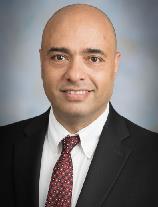Invited Speaker---Dr. Hussam Mahmoud

Dr. Hussam Mahmoud, George T. Abell Professor in Infrastructure, the Department of Civil Engineering, Colorado State University (CSU), America
Biography: Dr. Hussam Mahmoud is the George T. Abell Professor in Infrastructure in the Department of Civil Engineering at Colorado State University (CSU). He obtained his BS and MS in Civil Engineering from the University of Minnesota and his Ph.D. from the University of Illinois at Urbana Champaign (UIUC). Dr. Mahmoud’s research program has three major thrusts including assessing community resilience, quantifying building damage to extreme single and multiple hazards, and evaluating deteriorated infrastructure. For the first and second thrust, the focus is on assessment and developed of resilient systems subjected to extreme single and multiple, natural and manmade hazards including blasts, fire, earthquakes, tsunamis, and hurricanes or a combination of such. Dr. Mahmoud has authored numerous publications and he chairs and serves on various technical committees including ASCE fire protection, fatigue and fracture, steel bridges, and Multi-hazard committees, among others. He is the recipient of various awards including the American Institute of Steel Construction early faculty career award, the R. J. Dexter Memorial Lecture award, and the Air Force summer faculty fellowship award. Dr. Mahmoud’s work has also received various media coverage through citations and interviews including the Smithsonian Magazine, CBS Egypt – TV show Here is the Capital with Lamis Elhadidy, Business insider, among others.
Speech Title: Advances in Computational Methods for the Assessment of Structures under Fires and Fire Following Earthquakes
Abstract: Fires following earthquakes may occur in metropolitans with moderate-to-highly seismicity. The simultaneous ignitions – caused by strong earthquake – might turn to mass conflagrations in the affected area, leading to to catastrophic consequences including major structural damage as well as severe economic and social losses. In this talk, advances in numerical and analytical simulations of steel buildings under fire will be presented. This includes the integration between a newly developed mathematical formulation to evaluate the performance at the member level with detailed finite element simulations at the frame level under the umbrella of a new performance-based fire following earthquake engineering framework (PBFFE). In the PBFFE framework a stochastic model of the effective random variables controlling performance is utilized to generate fragility of steel columns and frames under the multiple hazards of earthquake and fire. The results demonstrate that instability can be a major concern in steel structures, both on the member and system levels, under the sequential events and highlights the need to develop provisions for the design of steel structures subjected to fire following earthquake.
References
[1] Qin, C. and Mahmoud, H. (2018) “Collapse Performance of Composite Steel Frames Under Fire,” Engineering Structures, Vol. 183, 662-676, https://doi.org/10.1016/j.engstruct.2019.01.032.
[2] Hemmati, M., and Mahmoud, H. (2018) “A Framework for Collapse Vulnerability Assessment of Steel Beams Subjected to Increasing Loads and Non-Uniform Longitudinal Temperature,” ASCE Journal of Structural Engineering, Vol. 145(5), 04018051-1, 10.1061/(ASCE)ST.1943-541X.0002287.
[3] Memari, M. and Mahmoud, H. (2018) “Predicting the Onset of Instability in Steel Columns Subjected to Earthquake Followed by Non-Uniform Longitudinal Temperature Profile,” ASCE Journal of Structural Engineering, Vol. 144(6), 04018051-1, https://doi.org/10.1061/(ASCE)ST.1943-541X.0002040.
[4] Memari, M. and Mahmoud, H. (2018) “Multi-Resolution Analysis of the SAC Steel Frames with RBS Connections under Fire”, Fire Safety Journal, Vol. 98, 90-108, https://doi.org/10.1016/j.firesaf.2018.04.008.
[5] Memari, M. and Mahmoud, H. (2018) “Framework for a Performance-Based Analysis of Fires Following Earthquakes,” Engineering Structures, Vol. 171, 794-805, https://doi.org/10.1016/j.engstruct.2018.05.099.
[6] Memari, M. and Mahmoud, H. (2018) “Design Formulation for Critical Buckling Stress of Steel Columns Subjected to Non-Uniform Fire Loads,” AISC Engineering Journal, Second Quarter, Vol. 55(2), 89-108.
[7] Memari, M. Mahmoud, H., and Ellingwood, B. (2018) “Stability of Steel Columns Subjected to Earthquake and Fire Loads,” ASCE Journal of Structural Engineering, 144(1), 04017173, https://doi.org/10.1061/(ASCE)ST.1943-541X.0001909.
[8] Mahmoud, H., Ellingwood, B., Turbert, C., and Memari, M. (2016) “Response of Reduced Beam Section Connections Exposed to Fire,” ASCE Journal of Structural Engineering, Vol. 142(1), 04016043, https://doi.org/10.1061/(ASCE)ST.1943-541X.0001340.
[9] Memari, M. Mahmoud, H., and Ellingwood, B. (2014) “Post-Earthquake Fire Performance of Moment Resisting Frames with Reduced Beam Section Connections,” Journal of Constructional Steel Research, Vol. 103, 215–229, https://doi.org/10.1016/j.jcsr.2014.09.008.
[10] Memari, M. and Mahmoud, H. (2014) “Performance of Steel Moment Resisting Frames with RBS Connections under Fire Loading,” Engineering Structures, Vol. 75, 126-138, https://doi.org/10.1016/j.engstruct.2014.05.040.
[11] Memari, M., Xuguang, W., Mahmoud, H., and Kwon, O.S. (2018) “Hybrid Simulation of Small-Scale Steel Braced Frame under Fire and Fire Following Earthquake,” ASCE Journal of Structural Engineering, In Press.


